So while the make-up of the Bulldogs midfield had changed, Smith felt opportunities to play in the middle next year would not open up.
“It was a perfect storm. The year before, they never used him in the centre (he attended a handful of centre bounces), but when they changed their onball(ers) to get more run this year, he was out with his knee. Now Richards is ahead of him,” a source close to Smith said on condition of anonymity.

Bailey Smith moving to the Cats to help build the next-generation Geelong midfield after the retirement of Joel Sewlwood (right), now a commentator Credit: Getty Images
The injury also exacerbated a drift from the playing group.
Smith was popular among his teammates and coaches and well liked, but his slightly diffident personality meant he could sometimes be viewed as aloof.
Loading
For a long time, the Bulldogs had a policy that allowed flexibility to their injured players while in rehab. It allowed them to do their training sessions at times of their pleasing. But their injury list was relatively short this year, particularly for those with long-term injuries, leaving Smith often doing sessions alone, possibly exacerbating the perception that he was drifting from the playing group.
There’s a narrative that Luke Beveridge, as Bulldogs coach, has favourites and falls in and out of love with some of his players. This could probably be said of any coach, but the perception strengthened at the Dogs when All-Australians Bailey Dale and Caleb Daniel were puddling around in the VFL in the early part of the season, while battlers got games ahead of them – although Dale did admit at the end of the season that there was a more obvious reason he was playing in the VFL: he was playing badly.
So, while there might be truth in this narrative about Beveridge, it is not accurate regarding Smith. Both those close to Smith and those within the club say the pair had a good relationship.
Smith’s problem at the Bulldogs appeared to be bad timing.
His timing for Geelong, in contrast, is ideal.
Two seasons after Joel Selwood’s retirement, the Cats are in the process of revitalising their midfield, inching out the ageing brigade of Patrick Dangerfield, Cam Guthrie and Mitch Duncan.
Like the Bulldogs, they are seeking to inject more runners into the middle of the ground. They brought Max Holmes onto the ball and targeted Smith to complement his dash.
Smith not only wants to play on ball, the Cats want him to play there.
For the Cats, Smith has the added benefit that he is already a favourite of the club’s key sponsor, and one of Geelong’s biggest employers, Cotton On. He is already an ambassador for the clothing brand, so the club can please a sponsor at the same time they please the coach.
Smith was signed to Cotton On when he last re-signed to stay at the Western Bulldogs, so he already has an established, independent market-value commercial arrangement with the sponsor of his new club. That deal could not be seen to be inflated as a backdoor payment to subvert the salary cap, but if the arrangement were to suddenly balloon in the next year or two, it would prompt questions from the AFL.
The Cotton On connection no doubt influenced, even subtly, Smith’s decision to make Geelong his club of choice once he decided to leave the Bulldogs.
Smith sat with Geelong players, friends and families at the preliminary final this year because of his Cotton On connection, a seating choice which displeased the Dogs.
Loading
He has already purchased a house nearby on the Surf Coast, and the chance to move out of Melbourne appealed to Smith given the tensions in his life between his acknowledged long-standing battle with serious mental health issues and the oppressive attention his fame brings him in Melbourne.
Whether this was a significant factor can only be answered by Smith, but he has acknowledged he needed a fresh start, on and off the field.
“It’s the people that Geelong breeds that’s drawn me there most. The footy stuff is always amazing and a lot of people’s number one thing, but (for me) it’s more the type of people that are within the four walls,” he said.
Keep up to date with the best AFL coverage in the country. Sign up for the Real Footy newsletter.









